Migrant integration statistics - at risk of poverty and social exclusion
Data extracted in 23 October 2023. Planned article update: September 2024.
Highlights
Among persons living in the EU, 46.2 % of non-EU citizens residing in the EU, 27.3% of EU citizens living in another EU country and 19.3% of nationals living in their own country faced the risk of poverty or social exclusion in 2022.
In 2022, the risk of poverty was particularly concentrated among non-EU citizens living in the EU (37.2%) when compared with the risk for EU citizens living in another EU country (22.1%) and the risk of EU nationals living in their own country (14.5%).
Among persons living in the EU, some 15.5% of non-EU citizens living in the EU were affected by severe material and social deprivation in 2022 compared with 7.8% of EU citizens living in another EU country and 5.8% of EU nationals living in their own country.
In 2022, some 16.7% of non-EU citizens residing in the EU were living in households with very low work intensity; for EU citizens of other EU Member States the share was 8.5%, while for EU nationals living in their own country it was 7.9%.
Share of persons aged 18 years and over at risk of poverty or social exclusion, by citizenship, EU, 2015-2022
This article presents European statistics on the risk of poverty or social exclusion among adults, with an analysis according to an individual's citizenship or country of birth. Information is presented for various groups of foreign citizens or foreign-born persons and compares these with EU nationals living in their own country or native-born persons living in their own country. Foreign citizens include EU citizens living in another EU Member State than their country of citizenship and non-EU citizens. Similarly, foreign-born persons include EU-born persons living in another EU Member State than their country of birth and non-EU-born persons. This article forms part of an online publication on migrant integration statistics.
Full article
The data presented in this article are from the EU statistics on income and living conditions (EU-SILC). The information presented generally refers to persons aged 18 years and over. For analysis by age, two additional age groups are presented: young persons (here defined as persons aged 16-29 years) and persons of working age (20–64 years). The latter age group is of particular interest as it is the focus for employment analyses in the Action Plan on Integration and Inclusion 2021–2027.
The population that is at risk of poverty or social exclusion refers to persons who are at risk of poverty, and/or severely materially and socially deprived and/or living in a household with a very low work intensity: in other words, persons in at least one (and possibly two or all three) of these situations.
Persons at risk of poverty or social exclusion
In 2022, there were 95 million persons at risk of poverty or social exclusion across the whole of the EU. This equated to 21.6 % of the EU population. Almost four-fifths (79.0 %) of the persons at risk of poverty or social exclusion (75 million) were aged 18 years and over, 57.0 % were aged 20–64 years (core working age) and 16.8 % were aged 16–29 years (young persons).
Figure 1 indicates that the risk of poverty or social exclusion in the EU was lower among EU nationals living in their own country than it was among foreign citizens throughout the period from 2015 to 2022. In 2022, around one-fifth (19.3 %) of EU nationals living in their own country faced such a risk. The share among EU citizens living in another EU country was somewhat higher (27.3 %) while that for non-EU citizens living in the EU was close to half (46.2 %).
During the period 2015–2022, the share of EU nationals living in their own country who were at risk of poverty or social exclusion fell in the EU from 22.3 % to 19.3 %. Most of this fall occurred between 2015 and 2019, as this share fell slightly in 2020 and remained stable in 2021, coinciding with the start of the COVID-19 pandemic. It dropped again in 2022.
For EU citizens living in another EU country, the risk of poverty or social exclusion rose from 31.2 % in 2015 to 32.1 % in 2016. It then fell to a low of 27.0 % in 2019, before increasing to 29.1 % in 2020, at the start of the crisis. The share fell back somewhat in 2021 and 2022, standing at 27.3 %.
For non-EU citizens living in the EU, the development was similar to that for citizens of other EU Member States, but with higher shares. Starting from 49.9 % in 2015, the share increased to 50.5 % in 2016 before falling to a low of 45.4 % in 2018 and 2019. It increased strongly in 2020 and 2021 to 48.7 % before dropping again in 2022.
A similar analysis of the time series from 2015 to 2022 based on migrants' country of birth is also presented in Figure 1. This indicates broadly similar developments in the EU as observed for the analysis by citizenship:
- The share of native-born persons living in their own country who were at risk of poverty or social exclusion was lower than that of persons born in other EU Member States, which in turn was lower than that of persons born outside the EU.
- The share of native-born persons living in their own country who were at risk of poverty or social exclusion fell between 2015 and 2020, stabilising in the most recent year for which data are available (2022).
- The share of EU-born persons living in another EU country and non-EU born persons living in the EU who were at risk of poverty or social exclusion fell between 2015 and 2019 and increased in 2020. However, the development in 2021 and 2022 was clearly different for the two subpopulations: the rate increased for those non-EU born in 2021 and then decreased in 2022, while it fell for those EU-born in 2021 and increased in 2022.
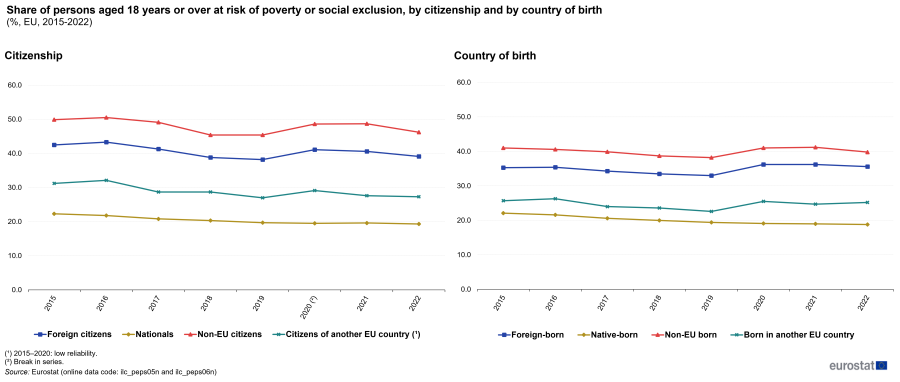
(%)
Source: Eurostat (ilc_peps05n) and (ilc_peps06n)
Figure 2 summarises the situation in the EU in 2022 for the two types of analyses (by citizenship and by country of birth). All of the shares by country of birth were lower than the shares by citizenship. The similar categories in each classification had shares of persons who were at risk of poverty or social exclusion that were broadly similar, but there were some differences:
- The closest shares were those observed for EU nationals living in their own country (19.3 %) and native-born persons living in their own country (18.8 %).
- The shares for EU citizens living in another EU country (27.3 %) and for EU-born persons living in another EU country (25.2 %) were somewhat further apart.
- The shares for non-EU citizens living in the EU (46.2 %) and for non-EU born persons living in the EU (39.8 %) were furthest apart.
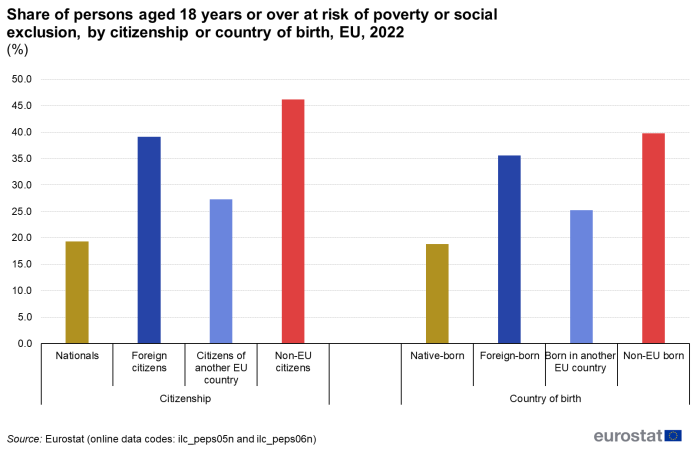
(%)
Source: Eurostat (ilc_peps05n) and (ilc_peps06n)
An analysis by citizenship for the EU Member States reveals that the share of foreign citizens at risk of poverty or social exclusion in 2022 was higher than that for nationals living in their own country in 22 of the 24 Member States for which data are available and reliable. In absolute terms, the difference ranged from 1.2 percentage points (pp) in Lithuania to 31.8 pp in Spain.
A more detailed analysis of the results for 2022 for the two subpopulations of foreign citizens reveals that the share of persons who were at risk of poverty or social exclusion was lower for EU nationals living in another EU country than for non-EU citizens living in the EU in 18 of the 19 Member States with available and reliable data. The only exception was Slovenia, where the shares were somewhat lower for non-EU citizens. The largest differences in the shares between these two foreign subpopulations were observed in France, the Netherlands and Greece.
The share of persons who were at risk of poverty or social exclusion in 2022 was the highest among the EU countries with reliable data in Spain and Italy for citizens of another EU country (39.4 % and 37.7 % respectively); for non-EU citizens, this share exceeded half in Greece (53.4 %), France (55.0 %) and Spain (60.4 %).
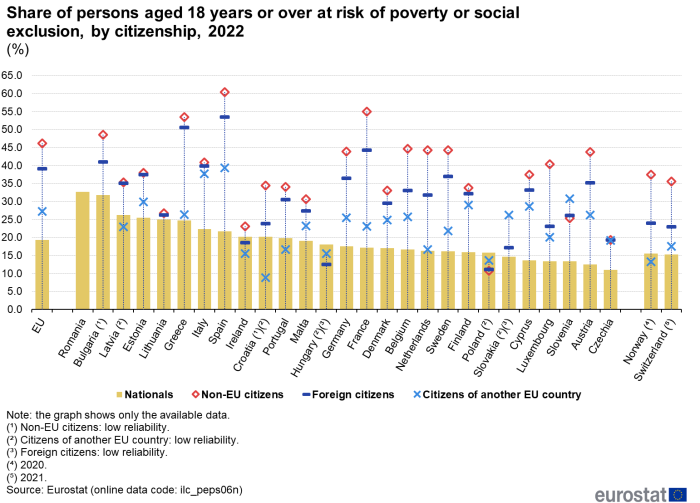
(%)
Source: Eurostat (ilc_peps05n)
Analysis by age
This section continues the analysis of the share of persons at risk of poverty or social exclusion according to citizenship or country of birth but adds an analysis by age.
For young persons (aged 16–29 years), the shares of persons at risk of poverty or social exclusion were higher than for the general age group of all persons aged 18 years and over. This was observed for all categories of citizenship and of country of birth analysed, in so far as data are available. For the age group 20–64 years, the shares of persons at risk of poverty or social exclusion were more similar to those for persons aged 18 years and over.
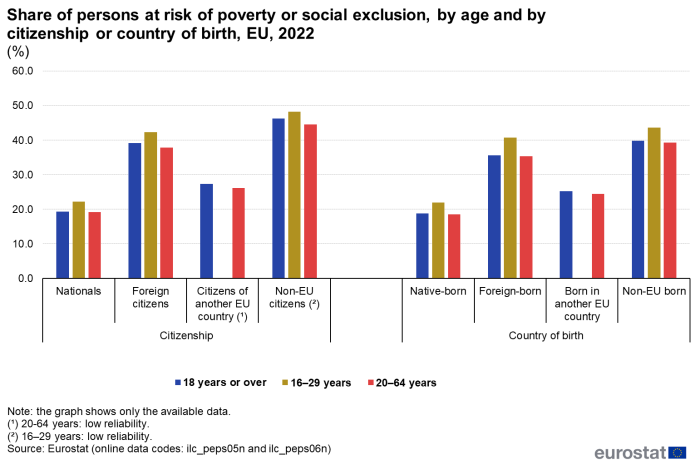
(%)
Source: Eurostat (ilc_peps05n) and (ilc_peps06n)
The additional analysis that look at the difference in shares compared with EU nationals living in their own country show that the share of persons at risk of poverty or social exclusion in the EU in 2022 was 19.8 pp higher for foreign citizens aged 18 years and over than for nationals. This difference was somewhat higher among those aged 16–29 years (20.1 pp) and slightly lower among those aged 20–64 years (18.7 pp).
For citizens of other EU Member States, the difference in the shares was 8.0 pp among persons aged 18 years and over. Again, the difference was somewhat lower among those aged 20–64 years (6.9 pp). For non-EU citizens, the difference in the shares was 26.9 pp among persons aged 18 years and over. This difference was somewhat lower among those aged 16–29 years (26.1 pp) and among those aged 20–64 years (25.4 pp).
The equivalent analysis by country of birth was similar. The difference in the shares (between native-born persons living in their own country and the various categories of migrants) was always larger for persons aged 16–29 years than for persons aged 18 years and over. However, there was no clear pattern in the difference in the shares for persons aged 20–64 years and those for persons aged 18 years and over, as these were almost identical.
Figures 5 compares the shares of foreign persons at risk of poverty or social exclusion in 2022 for two age groups, comparing the shares for young persons (aged 16–29 years) with those for persons of core working age (aged 20–64 years). In the EU, 42.3 % of young foreign citizens (aged 16–29 years) were at risk of poverty or social exclusion in 2022, compared with 37.9 % among foreign citizens aged 20–64 years.
- Finland, Ireland, Portugal, Spain, France and Slovenia were the only EU countries (among the 18 for which data are available and reliable) which recorded higher shares of foreign persons at risk of poverty or social exclusion among the core working age population than among young persons.
- The largest difference between the two age groups in the share of foreign persons at risk of poverty or social exclusion was in the Netherlands, where the share was 44.7 % for young foreign citizens compared with 31.6 % for foreign citizens aged 20–64 years.
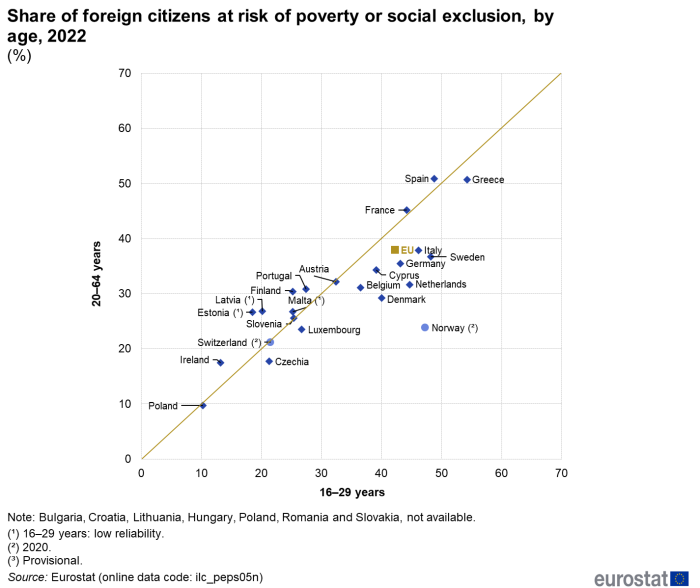
(%)
Source: Eurostat (ilc_peps05n)
Analysis by sex
This section adds an analysis by sex to the analyses by citizenship or country of birth for the share of persons (aged 18 years and over) at risk of poverty or social exclusion.
For men, the shares of persons at risk of poverty or social exclusion were lower than for women in the EU. This was observed in 2022 for all categories of citizenship and of country of birth analysed. The absolute differences between the two sexes in the shares of persons at risk of poverty or social exclusion were smallest for non-EU citizens / non-EU born persons living in the EU and largest for EU citizens / EU-born persons living in another EU country.
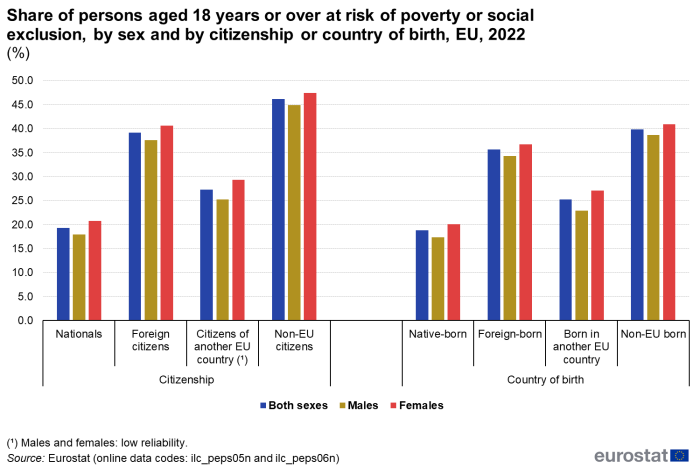
(%)
Source: Eurostat (ilc_peps05n) and (ilc_peps06n)
The additional analysis that look at the difference in shares compared with EU nationals living in their own country show that the share of males at risk of poverty or social exclusion in the EU in 2022 was 19.7 pp higher for foreign citizens than for EU nationals living in their own country; for females the difference was slightly higher, at 19.9 pp. A similar pattern was observed among EU citizens living in another EU country: the share for males was 7.3 pp higher than for EU nationals living in their own country, while for females the difference was again greater, at 8.6 pp. By contrast, for non-EU citizens living in the EU, the reverse was observed: the share for males was 27.0 pp higher than for EU nationals living in their own country, while for females the difference was smaller, at 26.7 pp. The equivalent analysis by country of birth was broadly similar.
Figure 7 compares the shares of foreign persons at risk of poverty or social exclusion in 2022 for men with women.
In the EU, 37.6 % of foreign men were at risk of poverty or social exclusion in 2022, compared with 40.6 % among foreign women.
- Austria, the Netherlands, Malta, Denmark and Poland were the only Member States (among the 21 for which data are available and reliable) which recorded higher shares of foreign men rather than foreign women at risk of poverty or social exclusion.
- The largest gender difference in the share of foreign persons at risk of poverty or social exclusion was in Latvia, with shares of 27.3 % for foreign men and 41.3 % for foreign women.
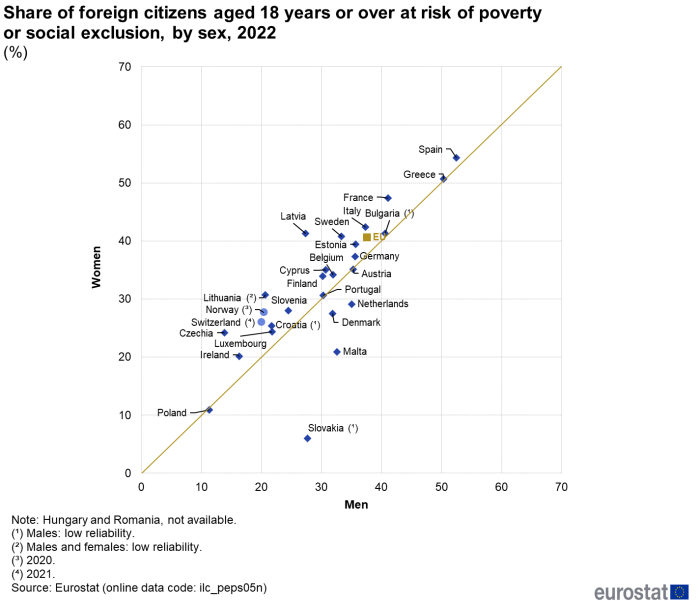
(%)
Source: Eurostat (ilc_peps05n)
At risk of poverty or social exclusion components
As explained in the beginning of this article, there are three groups of persons that are combined to calculate the share of the population that is at risk of poverty or social exclusion, namely: persons who are at risk of poverty, those facing severe material and social deprivation, and those living in households with very low work intensity. These groups can overlap, with some persons belonging to just one of the groups, some to two of them and some to all three.
At-risk-of-poverty rate
At risk of poverty is the first of the three different reasons for someone to be regarded as being at risk of poverty or social exclusion. The at-risk-of-poverty rate is defined as the proportion of persons that have an equivalised disposable income (after social transfers) below the at-risk-of-poverty threshold, which is set at 60 % of the national median equivalised disposable income (after social transfers). It should be noted that this indicator does not measure absolute poverty: rather, it shows the proportion of persons who have low incomes in comparison with other residents.
Figure 8 summarises the situation in the EU in 2022 for the two types of analyses (by citizenship and by country of birth). All of the rates by country of birth were lower than the shares by citizenship. The similar categories in each classification had shares of persons who were at risk of poverty that were broadly similar, but there were some differences:
- The closest at-risk-of-poverty rates were those observed for EU nationals living in their own country (14.5 %) and native-born persons living in their own country (14.0 %).
- The rates for EU citizens living in another EU country (22.1 %) and for EU-born persons living in another EU country (20.1 %) were somewhat further apart.
- The rates for non-EU citizens living in the EU (37.2 %) and for non-EU born persons living in the EU (31.7 %) were furthest apart.
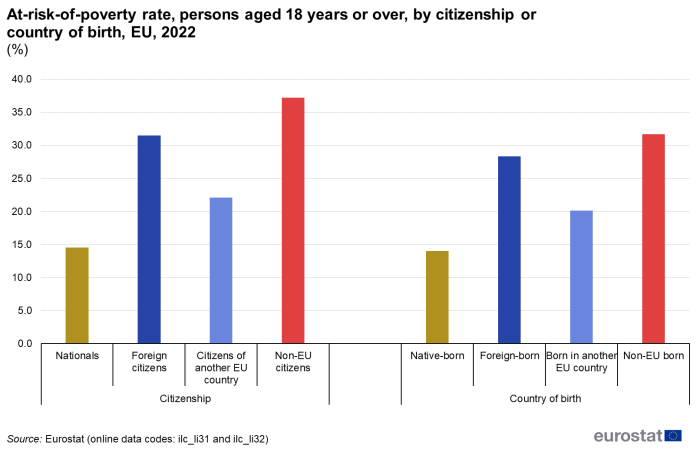
(%)
Source: Eurostat (ilc_li31) and (ilc_li32)
An analysis by citizenship for the EU Member States reveals that the share of foreign citizens at risk of poverty in 2022 was higher than that for nationals living in their own country in 22 of the 24 Member States for which data are available and reliable. The two exceptions were Ireland and Poland. In absolute terms, the difference ranged from 0.8 pp in Lithuania to 30.8 pp in Spain.
A more detailed analysis of the results for 2022 for the two subpopulations of foreign citizens reveals that the share of persons who were at risk of poverty was lower for EU citizens living in another EU country than for non-EU citizens living in the EU in 17 of the 19 Member States with available and reliable data. The two exceptions were Slovenia and Czechia, where the shares were lower for non-EU citizens. The largest differences in the shares between these two foreign subpopulations were observed in France and the Netherlands.
The share of persons at risk of poverty in 2022 was the highest among the EU countries with reliable data in Spain and Italy for citizens of another EU country (34.9 % and 34.2 % respectively); for non-EU citizens, this share exceeded half in Spain (52.7 %).
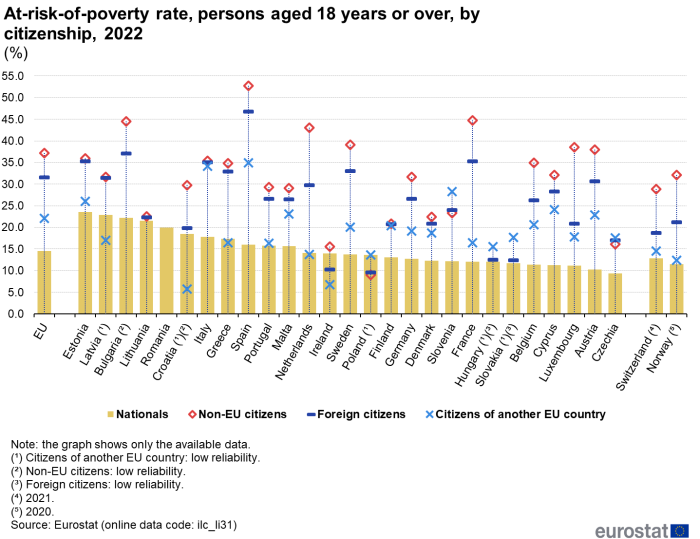
(%)
Source: Eurostat (ilc_li31)
Severe material and social deprivation rate
Severe material and social deprivation is the second of the three different reasons for someone to be regarded as being at risk of poverty or social exclusion. The severe material and social deprivation rate is an indicator that shows an enforced lack of necessary and desirable items to lead an adequate life. The indicator, distinguishes between individuals who cannot afford a certain good, service or social activities. It is defined as the proportion of the population experiencing an enforced lack of at least 7 out of 13 deprivation items (6 related to the individual and 7 related to the household).
Figure 10 summarises the situation in the EU in 2022 for the two types of analyses (by citizenship and by country of birth). Across the EU, some 15.5 % of non-EU citizens living in the EU were affected by severe material and social deprivation in 2022 compared with 7.8 % of EU citizens living in another EU country and 5.8 % of EU nationals living in their own country. All of the rates by country of birth were lower than the shares by citizenship: 13.0 % of non-EU born persons living in the EU, 7.1 % of EU-born persons living in another EU country and 5.6 % of native-born persons living in their own country faced severe material and social deprivation in 2022.
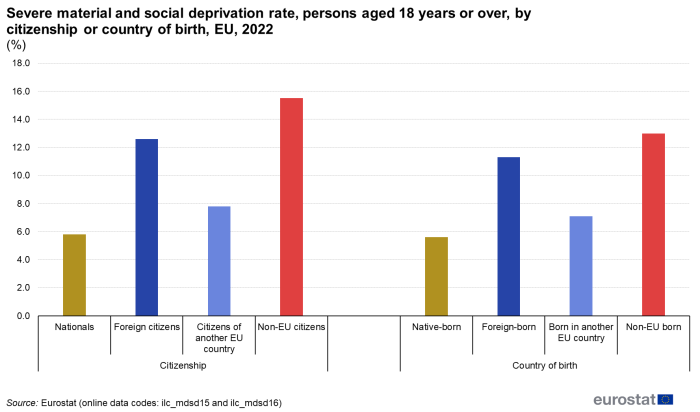
(%)
Source: Eurostat (ilc_mdsd15) and (ilc_mdsd16)
In 2022, among the EU Member States with reliable data the highest share of foreign citizens facing severe material and social deprivation was recorded in Greece, with more than one-third (37.6 %) of all foreign citizens affected. This rate was noticeably higher than in any of the other Member States, as the next highest shares recorded in Spain (18.5 %), Bulgaria and France (18.0 % both) were less than half of the rate for foreign citizens in Greece. At the other end of the range, the lowest severe material and social deprivation rates for foreign citizens were recorded in Poland (0.5 %) and Malta (1.3 %).
An analysis for 18 of the EU Member States with reliable data (see Figure.6 11 for coverage) reveals that in 15 of these it was more common for EU citizens living in another EU country to experience severe material and social deprivation than EU nationals living in their own country, while the reverse was true in two Member States; in Austria the rates were the same for EU nationals living in their own country and citizens of another EU country. Citizens of other EU Member States living in Slovenia were 5.8 times as likely as EU nationals living in their own country to be severely materially and socially deprived, while in Cyprus, Finland, Italy, Denmark, Luxembourg, the Netherlands and Czechia they were between two and four times as likely to face severe material and social deprivation. In Malta there was not a significant number of citizens of other EU Member States facing severe material and social deprivation in 2022.
In 2022, severe material and social deprivation in the EU was more widespread among non-EU citizens than it was among EU citizens living in another EU country. Across the EU Member States, it was relatively common to find that the share of non-EU citizens living in the EU suffering from severe material and social deprivation was higher than the share for citizens of other EU Member States, with particularly large absolute difference in Greece (20.1 pp).
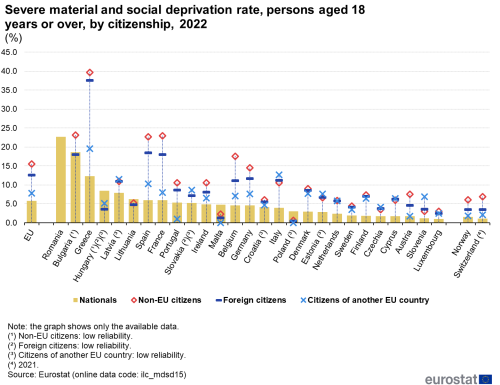
(%)
Source: Eurostat (ilc_mdsd15)
Persons living in households with very low work intensity
The final situation that contributes towards defining persons as being at risk of poverty or social exclusion is the share of persons living in households with very low work intensity; note that the age coverage of this indicator — persons aged 18-64 years — differs from that used in most of the remainder of the article. The indicator persons living in households with very low work intensity is defined as the number of persons living in a household where the members of working age worked a working time equal or less than 20% of their total work-time potential during the previous year.
Figure 12 summarises the situation in the EU in 2022 for the two types of analyses (by citizenship and by country of birth). The similar categories in each classification had shares of persons living in households with very low work intensity that were broadly similar or even identical:
- Across the EU, some 16.7 % of non-EU citizens living in the EU were living in households with very low work intensity in 2022 compared with 8.5 % of EU citizens living in another EU country and 7.9 % of EU nationals living in their own country.
- Some 14.8 % of non-EU born persons living in the EU, 8.5 % of EU-born persons living in another EU country and 7.7 % of native-born persons living in their own country were living in households with very low work intensity in 2022.
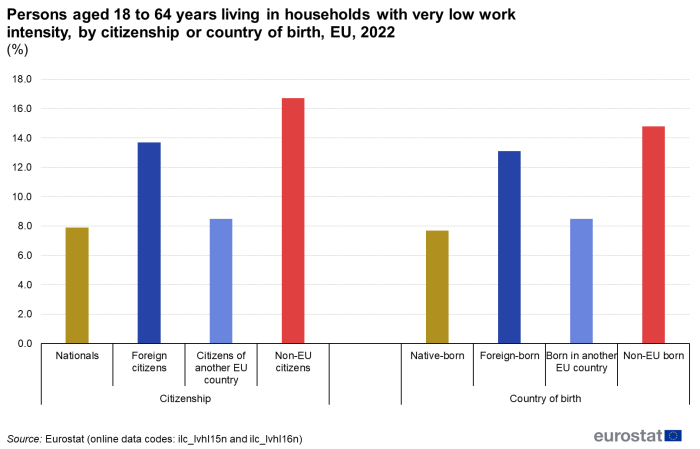
(%)
Source: Eurostat (ilc_lvhl15n) and (ilc_lvhl16n)
In 2022 among the EU countries with reliable data, Finland and Greece recorded the highest shares of citizens of other EU Member States living in households with very low work intensity, at 15.5 % and 13.0 % respectively. At the other end of the range, the share of citizens of other EU Member States living in households with very low work intensity was the lowest in Malta (0.2 %).
The highest shares of non-EU citizens living in households with very low work intensity in 2022 were recorded in Belgium and the Netherlands, 27.2 % and 26.9 % respectively. By contrast, there were 14 EU countries (among 22 with reliable data) where fewer than 1 in 10 non-EU citizens lived in households with very low work intensity. The lowest share was observed again for Malta (1.1 %).
Among the 18 EU Member States for which a complete data set was available, Italy, Denmark, Ireland, Luxembourg, Slovenia and Malta all recorded a higher share of nationals living in their own country — than both citizens of other EU Member States and non-EU citizens — living in households with very low work intensity in 2022.
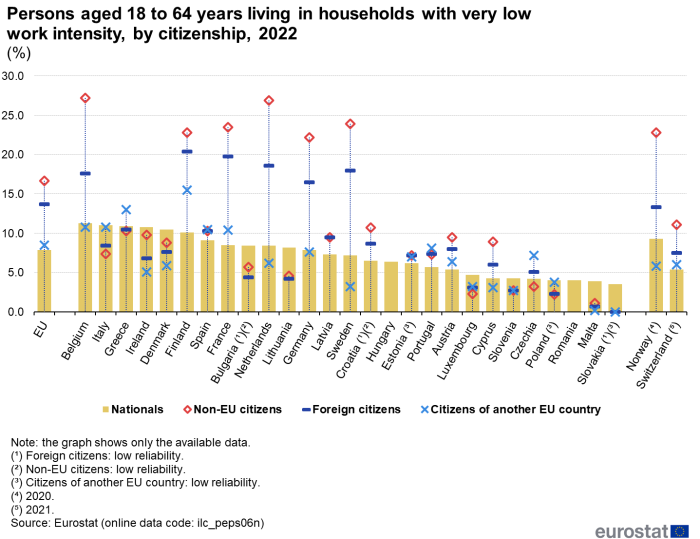
(%)
Source: Eurostat (ilc_lvhl15n)
Source data for tables and graphs
Data sources
The data presented in this article are from the EU statistics on income and living conditions (EU-SILC). Note that the age coverage used in this article may not be the same as that used by Eurostat in the area of social inclusion statistics and for this reason results may differ slightly from information that is published elsewhere. The population that is at risk of poverty or social exclusion refers to persons who are at risk of poverty, and/or severely materially and socially deprived and/or living in a household with a very low work intensity: in other words, persons in at least one (and possibly two or all three) of these situations. The at-risk-of-poverty rate is the share of persons with an equivalised disposable income (after social transfers) that is below the at-risk-of-poverty threshold, which is set at 60 % of the national median equivalised disposable income (after social transfers). The severe material and social deprivation rate relates to an enforced lack of necessary and desirable items to lead an adequate life. It is defined as the proportion of the population experiencing an enforced lack of (rather than a choice not to have) at least 7 out of 13 deprivation items (six related to the individual and seven related to the household). Examples include the lack of access to a car/van for personal use and getting together with friends/family for a drink/meal at least once a month. The share of persons living in households with very low work intensity is defined as the share of persons aged 0-64 years who are living in a household where the members of working-age (defined here as 18–64 years, other than students in the age group 18–24 years, retired persons or persons who receive pensions and inactive persons aged 60-64 years living in a household where the main income is pensions) worked 20 % or less of their total work-time potential during the previous year. The work intensity of a household is the ratio of the total number of months that all working-age household members worked during the previous year and the total number of months the same household members theoretically could have worked in the same period. Households composed only of children, students aged less than 25 years and/or of persons aged 65 years and over are excluded from the calculation. For more information on the data sources used, please consult EU statistics on income and living conditions (EU-SILC) methodology.
In several EU Member States, the detailed classification of foreign citizens and foreign-born persons identifies quite small numbers of persons. As the data source is a sample survey, the reliability of data in such cases may be low: data that are of low quality are published with an appropriate footnote while some data cannot be published for reasons of confidentiality.
Context
In November 2020, an Action Plan on Integration and Inclusion 2021–2027 (COM(2016) 377 final) was adopted with the purpose of fostering social cohesion and building inclusive societies for all. Inclusion for all is about ensuring that all policies are accessible to and work for everyone, including migrants and EU citizens with migrant background. This plan includes actions in four sectoral areas (education and training, employment and skills, health and housing) as well as actions supporting effective integration and inclusion in all sectoral areas at the EU, Member State and regional level, with a specific attention paid to young persons. More information on the policies and legislation in force in this area can be found in an introductory article on migrant integration statistics.
Direct access to
Online publications
- Foreign-born people and their descendants
- Living conditions in Europe
- Migrant integration statistics
Methodology
- Social inclusion (mii_soinc)
- Income distribution and monetary poverty (mii_ip)
- People at risk of poverty and social exclusion (mii_pe)
- Persons at risk of poverty or social exclusion by group of citizenship (population aged 18 and over) (ilc_peps05n)
- Persons at risk of poverty or social exclusion by group of country of birth (population aged 18 and over) (ilc_peps06n)
- Living condition (mii_lc)
- Material deprivation (mii_md)